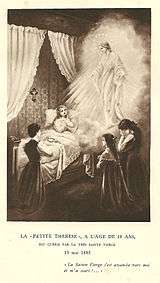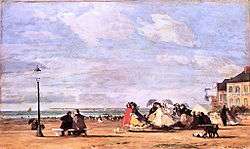The Story of a Soul

The Story of a Soul (l'Histoire d'une Âme) is the autobiography of Thérèse of Lisieux, a French Discalced Carmelite nun, later recognized as a saint. It was first published on September 30, 1898, a year to the day after her death from tuberculosis at the age of 24, on September 30, 1897. The book was a single volume formed from three distinct manuscripts - manuscripts of different length, written at different times, addressed to different people, and differing from one another in character. The work of unifying these disparate manuscripts was carried out by Pauline, the sister of Thérèse. It was initially published with a limited audience in mind, the Carmelite convents and certain religious personalities, and just 2000 copies of the 475 page book were printed.[1] It quickly became a publishing phenomenon however and Sister Thérèse of the Child Jesus was canonised in 1925.
Background

Thérèse Martin was the youngest of nine children, of whom four entered the Carmelite convent in the Normandy town of Lisieux. She was known as the Little Flower, and her autobiography is also known as The Springtime History of a Little White Flower.
Manuscripts

Manuscript A, entitled The Story of a Little White Flower, and dedicated to her sister Pauline, was written between the beginning of January 1895, and the 20 January 1896. Pauline has described how, as she sat with her sisters on a winter evening in the one room of Carmel where there was a fire, the writing of the first manuscript was decided. " One evening in the beginning of the year 1895, I was with my two sisters Marie and Thérèse. Sister Thérèse of the Child Jesus told me several happenings of her childhood and Sister Marie of the Sacred Heart (my eldest sister Marie) said to me; 'O Mother, what a pity that all this should not be written down for us. If you were to ask Sister Thérèse to write down her childhood memories, how much pleasure this would give us!'..I turned to Sister Thérèse, who laughed as though we were teasing her, and said: 'I order you to write down your memories of your childhood.' " [2]

Manuscript B is a letter to Sister Marie of the Sacred Heart (the eldest sister of Thérèse), and written at her request in three days between the 13 and 16 September 1896. Marie asked Thérèse to write down her spiritual discoveries, what Marie described as her little way of trust and love.[3] Thérèse replied in ten closely written pages. "Her many corrections show that she wrote in great haste and in a state of extreme fatigue." [4]
Manuscript C is a notebook written for the prioress of the Carmel Reverend Mother Marie de Gonzague. It was begun on 3 June 1897 and finished early in July, 1897. The origin of the third part of the autobiography of Thérèse has been described by Pauline: "It seemed to me that these accounts were incomplete. Sister Thérèse of the Child Jesus had concentrated on her childhood and early youth as I had asked her to do, her life as a nun was hardly sketched in. ... I thought it a great pity that she had not described the development of her life in the Carmel in the same way, but just then I had ceased to be Reverend Mother and Mother Marie de Gonzague held this office ... seeing that Sister Thérèse was so ill..about midnight on the evening of the 2 June 1897 ... I went to see Mother Prioress." [5] Pauline asked the Prioress to order Thérèse to write about her life as a religious and the next morning Marie de Gonzague did so, so that Thérèse went on with her account. Most of this manuscript was written during the month of June, 1897. Thérèse stopped writing in the first days of July, 1897. " Eventually the pencil fell from her hand as she wrote the last word, love. It is the final word of all three manuscripts." [6]
Pauline divided Thérèse's three manuscripts into eleven chapters and added a twelfth in which she summarized the last months of her life. Finally, she supplemented the work with some of Thérèse's poetry and with extracts from her correspondence. The twelve chapters of The Story of a Soul were printed in small format in 1902: An Unpetalled Rose. By 1906, The Story of a Soul was already translated into six languages (English, Polish, Dutch, Italian, Portuguese and Spanish).[7]
Influences
The Story of a Soul has influenced a number of people, e.g. Maria Candida of the Eucharist.[8]
See also
References
- ↑ Therese and Lisieux, Pierre Descouvement and Helmuth Nils Loose ISBN 1-85390-381-7
- ↑ Affidavit by the Reverend Mother Agnes of Jesus. Bayeux Archives, Vol 1
- ↑ Actes officiels du Procès deposés dans les Archives de l'Évêché de Bayeux volume one - depositions made by 37 witnesses about the life of Thérèse to an ecclesiastic tribunal instituted by Bishop Lemonnier of Bayeux in 1910
- ↑ Fr. Francoise de Sainte Marie, O.C.D, in Introduction , Autobiography of a Saint p.13, tr: Ronald Knox, ISBN 0-00-623577-8
- ↑ Quoted from Bayeux depositions, Introduction, Autobiography of a Saint p.13
- ↑ Introduction Autobiography of a Saint, p14
- ↑ Therese and Lisieux, p 312, Descouvement, Loose
- ↑ Biography at the Vatican Website
Bibliography
- Story of a Soul: the Autobiography of St. Therese of Lisieux, translated from the original manuscripts by John Clarke, O.C.D. Third edition, 1996. ISBN 0935216588.
- The Story of a Soul: The Autobiography of St. Therese of Lisieux with Additional Writings and Sayings of St. Therese, ed. Paul A. Boer Sr.. CreateSpace Independent Publishing, 2012. ISBN 1479207470.
External links
| Wikimedia Commons has media related to Biography of Thérèse Martin (Histoire d'une âme). |
- "Story of a Soul: The Autobiography of St. Therese of Lisieux (Online)". Christian Classics Ethereal Library.
- "The Story of a Soul (L'Histoire d'une Âme): The Autobiography of St. Thérèse of Lisieux (Ebook)". Project Gutenberg.
- "Story Of A Soul (Online Audiobook)".